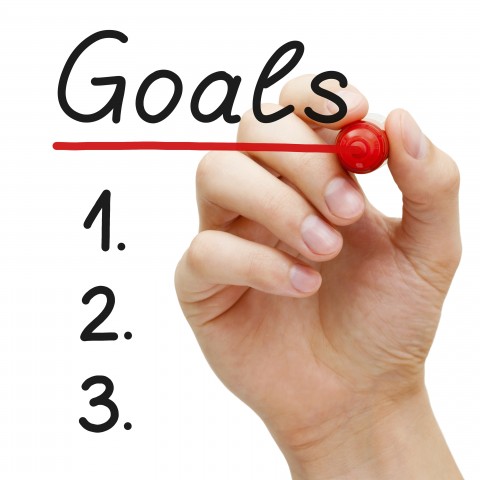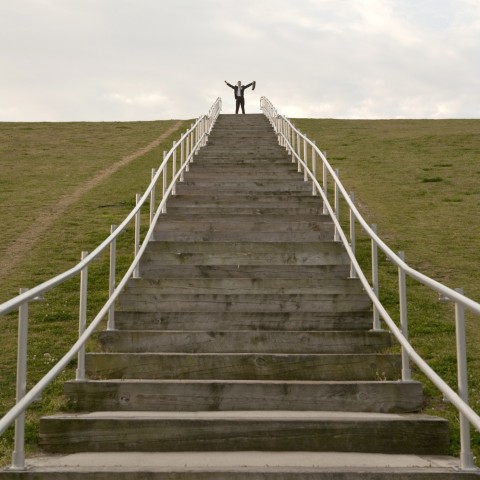There’s no denying that K-Pop has taken over the world and played a huge role in popularizing the Korean language. According to The Korea Herald, the King Sejong Institute is busy at work opening new Korean-language learning centers around the globe. This institute currently operates 172 branches and teaches Korean to 57,000 students in 56 different countries.
Whether you’re learning the Korean language to understand the lyrics of your favorite K-Pop songs or to follow along with the subtitles for Korean films, you’ve come to the right place!
Korean tenses are an essential part of the Korean language you should become familiar with early on. In today’s article, we’ll teach you about the present, past, and future tenses in Korean and show you how they’re formed. The information provided here is intended for beginners, but intermediate and advanced students can also read it to brush up on their skills.
Let’s go!

Having a goal is very important in learning the Korean language.
 Table of Contents
Table of Contents
1. Present Tense
The Korean present tense is used to describe something that is happening in the present. Take the English phrases “I eat” and “I drink,” for example. There are three different ways to form the present tense in Korean.
RULE #1
When the last syllable of the stem ends in a consonant, -는다 (-neunda) is added to the stem of the word.
For example:
- 먹다 (meokda) – “to eat”
- 먹 (meok) + 는다 (neunda) = 먹는다 (meokneunda) or “I eat”
- 닫다 (datda) – “to close”
- 닫 (dat) + 는다 (neunda) = 닫는다 (datneunda) or “I close”
Example sentences:
- 라면을 먹는다. (Ramyeoneul meokneunda.) – “I eat ramen.”
- 문을 닫는다. (Muneul datneunda.) – “I close the door.”
RULE #2
When the last syllable of the stem ends in a vowel, -ㄴ (-n) is added to the last syllable followed by 다 (da).
For example:
- 배우다 (baewuda) – “to learn”
- 배우 (baewu) + ㄴ다 (nda) = 배운다 (baewunda) or “I learn”
- 공부하다 (gongbuhada) – “to study”
- 공부하 (gongbuha) + ㄴ다 (nda) = 공부한다 (gongbuhanda) or “I study”
- 가다 (gada) – “to go”
- 가 (ga) + ㄴ다 (nda) = 간다 (ganda) or “I go”
- 오다 (oda) – “to come”
- 오 (o) + ㄴ다 (nda) = 온다 (onda) or “I come”
Example sentences:
- 영어를 배운다. (Yeongeoreul baewunda.) – “I learn English.”
- 한국어를 공부한다. (Hangukeoreul gongbuhanda.) – “I study Korean.”
- 집으로 간다. (Jibeuro ganda.) – “I go home.”
- 친구가 온다. (Chinguga onda.) – “My friend comes.”
RULE #3
This grammar rule is used to describe something happening right now, such as “I am eating” and “I am drinking” in English.
Remove the stem and simply add -고 있어요 (-go itseoyo) to complete the sentence.
For example:
- 먹다 (meokda) – “to eat”
- 먹 (meok) + 고 있어요 (go isseoyo) = 먹고 있어요 (meokgo isseoyo) or “I’m eating”
- 마시다 (masida) – “to drink”
- 마시 (masi) + 고 있어요 (go isseoyo) = 마시고 있어요 (masigo isseoyo) or “I’m drinking”
- 입다 (ibda) – “to put on” or “to wear”
- 입 (ib) + 고 있어요 (go isseoyo) = 입고 있어요 (ipgo isseoyo) or “I’m wearing”
Example sentences:
- 밥을 먹고 있어요. (Babeul meokgo isseoyo.) – “I am eating some rice.”
- 물을 마시고 있어요. (Mureul masigo isseoyo.) – “I am drinking some water.”
- 드레스를 입고 있어요. (Deureseureul ipgo isseoyo.) – “I am wearing a dress.”

The conversation will be a lot smoother if you can construct tenses correctly.
2. Past Tense
The past tense is used to describe actions that took place at some point in the past, which is especially important in storytelling or conveying certain types of information. There are three ways to form the Korean past tense.
RULE #1
When the final vowel of a verb is ㅗ (o) orㅏ(a), add -았다 (-atda).
For example:
- 만나다 (mannada) – “to meet”
- 만나 (manna) + 았다 (atda) = 만났다 (manatda) or “I met”
- 가다 (gada) – “to go”
- 가 (ga) + 았다 (atda) = 갔다 (gatda) or “I went”
Example sentences:
- 친구를 만났다. (Chingureul mannatda.) – “I met a friend.”
- 집으로 갔다. (Jibeuro gatda.) – “I went home.”
RULE #2
When the final vowel of a verb is anything but ㅗ (o) orㅏ(a), add -었다 (-eotda).
For example:
- 먹다 (meokda) – “to eat”
- 먹 (meok) + ~았다 (-atda) = 먹었다 (meokatda) or “I ate”
- 배우다 (baewuda) – “to learn”
- 배우 (baewu) + ~았다 (-atda) = 배웠다 (baeweotda) or “I learned”
Example sentences:
- 수박을 먹었다. (Subageul meogeotda.) – “I ate a watermelon.”
- 한국어를 배웠다. (Hangugeoreul baeweotda.) – “I studied Korean.”
RULE #3
If a verb ends with the syllable 하 (ha), add -였다 (-yeotda).
For example:
- 요리하다 (yorihada) – “to cook”
- 요리하 (yoriha) + 였다 (yeotda) = 요리했다 (yorigatda) or “I cooked”
- 공부하다 (gongbuhada) – “to study”
- 공부하 (gongbuha) + 였다 (yeotda) = 공부했다 (gongbuhaetda) or “I studied”
Example sentences:
- 한식을 요리하다. (Hansigeul yorihada.) – “I cooked Korean dishes.”
- 요리를 공부했다. (Yorireul gongbuhaetda.) – “I studied cooking.”

Learning the Korean language takes time, but it’s absolutely worth it!
3. Future Tense
The future tense is used to talk about future events. There are two Korean future tenses: one that describes something that will happen in the future and one that describes what might happen.
Simple Future Tense
The simple future tense is very easy to learn because all you need to do is add -겠다 (-getta) to the stem of a verb. Simple, right?
For example:
- 배우다 (baewuda) – “to learn”
- 배우 (baewu) + 겠다 (getda) = 배우겠다 (baewugetda) or “I will learn”
- 먹다 (meokda) – “to eat”
- 먹 (meok) + 겠다 (getda) = 먹겠다 (meokgetda) or “I will eat”
- 가다 (gada) – “to go”
- 가 (ga) + 겠다 (getda) = 가겠다 (gagetda) or “I will go”
- 키우다 (kiuda) – “to raise”
- 키우 (kiu) + 겠다 (getda) = 키우겠다 (kiugetda) or “I will raise”
Example sentences:
- 포토샵을 배우겠다. (Potosyapeul baewugetda.) – “I will learn Photoshop.”
- 나중에 먹겠다. (Najunge meokgetda.) – “I will eat later.”
- 저녁에 가겠다. (Jeonyuge gagetda.) – “I will go in the evening.”
- 토끼를 키우겠다. (Tokkireul kiwugetda.) – “I will raise a rabbit.”
Probable Future
The probable future tense is used when you want to say, “I will probably ___.” The rule is to attach 으 (eu) or ㄹ 거에요 (r geoyeyo) to the verb stem.
Here are the rules:
1) If the stem ends in a consonant, attach 을 거예요 (eul geoyeyo).
2) If it ends in a vowel, attach ㄹ 거예요 (r geoyeyo).
- 먹다 (meokda) – “to eat”
- 먹 (meok) + 을 거예요 (eul geoyeyo) = 먹을 거예요 (meogeul geoyeyo) or “I will probably eat”
- 가다 (gada) – “to go”
- 가 (ga) + ㄹ 거예요 (r geoyeyo) = 갈 거예요 (gal geoyeyo) or “I will probably go”

Revise, revise, and revise! It is the fastest way to learn Korean well.
4. Revise Your Knowledge with KoreanClass101!
How about a quick exercise to revise everything you’ve learned today?
Below is a table featuring words from our free list “Vocabulary for the 25 Most Commonly Used Verbs of Any Language.” You can either print out this page or get a notebook ready, and fill in the answers for the blank cells. Don’t be discouraged if you struggle to remember the correct answers! When you’re done with the exercise, simply drag each column to see the answer.
| Dictionary Form | Present Tense | Past Tense | Future Tense |
| 먹다 (meokda) | 먹는다 (meokneunda) | 먹었다 (meokeotda) | 먹겠다 (meokgetda) |
| 가다 (gada) | 간다 (ganda) | 갔다 (gatda) | 가겠다 (gagetda) |
| 사용하다 (sayonghada) | 사용한다 (sayonghanda) | 사용했다 (sayonghaetda) | 사용하겠다 (sayonghageta) |
| 보다 (boda) | 본다 (bonda) | 봤다 (bwatda) | 보겠다 (bogetda) |
| 일하다 (ilhada) | 일한다 (ilhanda) | 일했다 (ilhaeta) | 일하겠다 (ilhageta) |
| 말하다 (malhada) | 말한다 (malhanda) | 말했다 (malhaetda) | 말하겠다 (malhagetda) |
| 오다 (oda) | 온다 (onda) | 왔다 (watda) | 오겠다 (ogetda) |
| 마시다 (masida) | 마신다 (masinda) | 마셨다 (masyeotda) | 마시겠다 (masigetda) |
| 자다 (jada) | 잔다 (janda) | 잤다 (jatda) | 자겠다 (jageta) |
| 생각하다 (saengakhada) | 생각한다 (saengakhanda) | 생각했다 (saengakhaetda) | 생각하겠다(saengakhageta) |
| 알아듣다 (aladeutda) | 알아듣는다 (aladeutneunda) | 알아들었다 (aladeuleotda) | 알아들겠다 (aladeulgetda) |
| 물어보다 (mureoboda) | 물어본다 (mureobonda) | 물어봤다 (mureobwatda) | 물어보겠다 (mureobogetda) |
| 주다 (juda) | 준다(junda) | 줬다 (jweotda) | 주겠다 (jugetda) |
| 시작하다 (sijakhada) | 시작한다(sijakhanda) | 시작했다 (sijakhaetda) | 시작하겠다 (sijakhagetda) |
How many did you get right? If you’re still struggling to understand Korean tenses, go back to the corresponding section from the article and try it again. Practice makes perfect!
Here’s another list of Korean verbs from our website that you can use to practice the past, present, and future tenses:
And here are lessons that we made just for you (that is, if you’re an absolute beginner):
- Korean Past Tense: Did You Wash Yourself or Brush Your Teeth?
- Using Korean Future Tense: When Are You Going on Vacation?
- I Did It, I’m Doing It, And I’m Going To Do It
Did you find those too easy? Here are some pages for intermediate and advanced learners:
Check out these other pages from the web to learn more about Korean-language verbs in general:
- Korean verbs (Wikipedia)
- Korean verbs (Wiktionary)
5. Why Learn with Us?
KoreanClass101 offers free vocabulary lists and a free dictionary where you can learn new words and practice their pronunciation. We also have a Korean word of the day feature, which allows you to receive a free daily Korean lesson from us. We know that some Korean learners love challenging themselves by memorizing a word everyday, so we’ve also compiled the Korean Core 100 Word List so that you can challenge yourself and learn Korean words that are used every day in Korea. We also have 200-, 300-, and 2000-word lists! So do check them out if you’re up to the challenge!
Have a question? Feel free to leave a comment below or simply visit our forum page where you can learn all about Korea and practice your language skills. A lot of Korean learners share their Korean travel experiences and provide learning tips here. In addition, native Korean speakers also visit this page to help Korean learners like yourself.
We hope you enjoyed reading this article, and good luck with your Korean studies!










